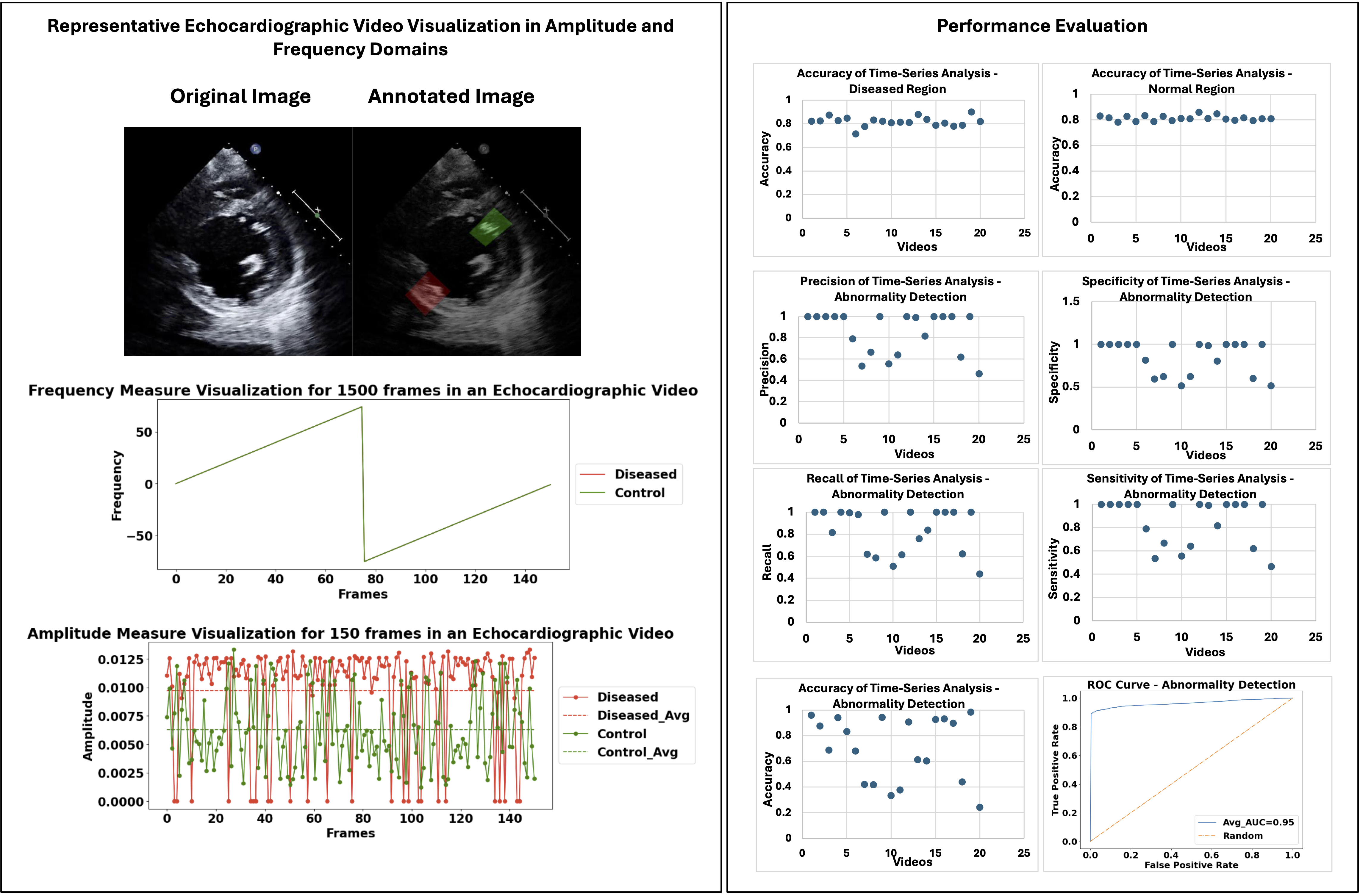Final ID: P3086
Future Heart Motion Measurements in Deep Learning-based Predictive Imaging
Abstract Body: INTRODUCTION: Predicting the motion of heartbeats and the progression of cardiovascular diseases offers potential opportunities to provide early warnings and timely prevention, diagnosis, and/or treatment. However, quantitative measurement for predicting subsequent heart motion in medical imaging is unclear. We hypothesized that amplitude measurement in the frequency domain can be used to detect subsequent heart motion in a recurrent neural network architecture.
METHODS: We performed image annotations on two-dimensional echocardiographic videos from the public domain and defined the Regions of Interest from diseased/control left ventricular (LV) areas of beating human hearts (20 videos with 1500 frames each). Pathologies included myocardial infarction and aortic aneurysms. Following the reduction of video frames into one-dimensional sequences, we converted the sequences into the frequency domain using Fast Fourier Transform. We also used a deep learning-based recurrent neural network architecture, especially Long Short-Term Memory model to perform both one-class and two-class Time-Series Analyses. We subsequently performed quantitative evaluation of the analyses.
RESULTS: The Time-Series Analysis of amplitude measurements was able to successfully predict subsequent frames. For one-class Time-Series Analysis, the average accuracy for high-quality videos was 0.82 for both control and diseased regions. For all videos, the accuracy was 0.81 for control regions and 0.82 for diseased regions. For two-class abnormality detection, the average precision was 0.9996 for high-quality videos and 0.9353 for all videos, the average recall was 0.98116 for high-quality videos and 0.9215 for all videos, the average specificity was 0.9995 for high-quality videos and 0.9353 for all videos, the average sensitivity was 0.9996 for high-quality videos and 0.9353 for all videos, and the average accuracy was 0.8918 for high-quality videos and 0.8378 for all videos. We also generated the Area Under the Receiver Operating Characteristic curve (AUROC), and its average was 0.95.
CONCLUSIONS: Using Fast-Fourier Transform and Long Short-Term Memory model, we successfully measured future heartbeats in both diseased and control LV walls. The results showed high precision, recall, sensitivity, specificity, and Receiver Operating Characteristics. These suggest that the progression of regional wall motion abnormalities may be predicted in cardiovascular diseases.
METHODS: We performed image annotations on two-dimensional echocardiographic videos from the public domain and defined the Regions of Interest from diseased/control left ventricular (LV) areas of beating human hearts (20 videos with 1500 frames each). Pathologies included myocardial infarction and aortic aneurysms. Following the reduction of video frames into one-dimensional sequences, we converted the sequences into the frequency domain using Fast Fourier Transform. We also used a deep learning-based recurrent neural network architecture, especially Long Short-Term Memory model to perform both one-class and two-class Time-Series Analyses. We subsequently performed quantitative evaluation of the analyses.
RESULTS: The Time-Series Analysis of amplitude measurements was able to successfully predict subsequent frames. For one-class Time-Series Analysis, the average accuracy for high-quality videos was 0.82 for both control and diseased regions. For all videos, the accuracy was 0.81 for control regions and 0.82 for diseased regions. For two-class abnormality detection, the average precision was 0.9996 for high-quality videos and 0.9353 for all videos, the average recall was 0.98116 for high-quality videos and 0.9215 for all videos, the average specificity was 0.9995 for high-quality videos and 0.9353 for all videos, the average sensitivity was 0.9996 for high-quality videos and 0.9353 for all videos, and the average accuracy was 0.8918 for high-quality videos and 0.8378 for all videos. We also generated the Area Under the Receiver Operating Characteristic curve (AUROC), and its average was 0.95.
CONCLUSIONS: Using Fast-Fourier Transform and Long Short-Term Memory model, we successfully measured future heartbeats in both diseased and control LV walls. The results showed high precision, recall, sensitivity, specificity, and Receiver Operating Characteristics. These suggest that the progression of regional wall motion abnormalities may be predicted in cardiovascular diseases.
More abstracts on this topic:
A Randomized Comparison of Online Motivational Themes in Cardiovascular Clinical Trial Recruitment
Hussain Zaib, Harry Tamunotonye, Michos Erin, Milller Hailey, Juraschek Stephen, Turkson-ocran Ruth-alma, Lahey Timothy, Feng Yuanyuan, Plante Timothy
A novel reproducible low-cost model of acute myocardial infarction in swineLi Yichen, Zheng Zilong, Tang Weijie, Chen Wangping, Yang Jinfu, Fan Chengming

